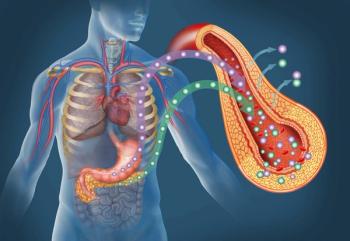
Enterovirus D68: How Did the Current Outbreak Begin?
Notable outbreaks over the past 2 decades have qualified enterovirus D68 as an emerging pathogen.
Respiratory illness related to enterovirus D68 (EV-D68) infection has emerged with increasing frequency in recent years. Although similar viruses were identified in 4 patients in 1962, over the past 2 decades, notable outbreaks have accelerated across North America, Europe, and Asia, qualifying EV-D68 as an emerging pathogen that is most often reported in young children.1,2
Circulating strains that cause respiratory disease are of diverse types that have emerged in several locations across the globe. Several distinct strains of EV-D68 are spreading rapidly between countries and continents.2
In 2013, investigators Garcia et al studied human enterovirus (HEVs) and human rhinoviruses (HRVs) in Latin America, using nasopharyngeal swabs across 8 Latin American countries in 3375 patients with flu-like symptoms. About half of patients in the study were under the age of 3 years, although some patients were up to 25 years of age.
A total of 3% of subjects had human EV infections. However, in the study, Columbia and Nicaragua had the highest rates of infection due to HEVs and HRVs.3
In Nicaragua, influenza-like viruses related to HRVs and HEVs exceeded 25% of cases and in Columbia, these viruses were associated with more than 20% of respiratory illnesses. Among those identified viruses were EV-D68 and EV-A71.3
In a 2014 outbreak of EV infection across the United States, investigators affiliated with the US Centers for Disease Control and Prevention (CDC) identified EV-D68 as the causative pathogen in 19 of 22 cases reported in Kansas City. EV-D68 infection was also associated with 11 of 14 cases reported in Chicago.
Previously in the United States, EV-D68 was uncommon. A total of 79 cases occurred from 2009 to 2013, according to the National Enterovirus Surveillance System. This recent outbreak represents a substantial growth in the incidence of EV-D68.3
The spread of EV-D68 and other viruses around the world is concerning considering that the disease can lead to hospitalizations that, in some cases, require ventilatory support. Deaths associated with EV-D68 infection have also been reported.1-3
Most recently, a young child in New Jersey died of EV-D68 infection, and 5 new cases were reported in the state.4,5
In a phone interview with Pharmacy Times, Dr. Steve Oberste, PhD, chief of the Polio and Picornavirus Laboratory Branch at the CDC in Bethesda, MD, noted that the recent US outbreak, “is actually related to the strains that were in the United States over the last couple of years.”
The most recent outbreaks, according to Oberste, occurred, “in the US, Europe, and Asia about 5 years ago…by next year, the current outbreak will probably be in Europe or Asia.” Enteroviruses, which belong to a genus that includes over 100 different viruses, often do not cause symptoms.
Oberste explained, “One of the keys with enteroviruses and rhinoviruses is that actually the vast majority of people who are infected have very little to no symptoms.”
In other words, these viral outbreaks tend to persist at a low level—often asymptomatically—in a certain segment of the population, and reemerge due to unknown factors.
In response to questions about possible reservoirs in the environment, Oberste stated that no natural source of the enteroviruses is currently known.
“There is no known link with any kind of ecological or climate factors,” he noted.
It is possible for enterovirus, including EV-D68, to persist at low levels in the environment. According to Oberste, “The vast majority (over 90%) will be either asymptomatic or will have very mild symptoms.” Many more people may have EV-D68 than has currently been reported.
Enterovirus outbreaks are not uncommon. Each year 10 to 15 million people in the United States develop minor enterovirus infections, the vast majority of which cause few symptoms. However, 10,000 to 15,000 patients will present with, “a spectrum of illness, most commonly aseptic meningitis, a viral meningitis, which fortunately is not as severe as the bacterial form.”
In severe cases, EV-D68 may cause paralysis.
Although some leading experts, such as Oberste, believe EV-D68 infection is a resurgence of a circulating strain, a difference of opinion exists among experts. For instance, leading enterovirus researcher Rafal Tokarz, PhD, of the Center for Infection & Immunity at the Mailman School of Public Health at Columbia University, noted that the symptoms in this most recent outbreak tend to be more serious than those in previous outbreaks, unlike strains that were previously circulating at lower levels.
Tokarz also noted that the virus is evolving. In an interview with the New York Times, Tokarz noted, “A hypothesis of mine is that the strain that’s circulating now probably is a novel variant. It may have mutated into something that’s more easily transmissible and more pathogenic.” He continued, “The virus is mutating, and there are a lot of different variants circulating around the globe.”6
Previous clusters observed in the United States include an EV-D68 cluster observed in New York City in 2009, dispersed clusters in 2010, and 5 cases of a polio-like illness in California last winter that may or may not have been EV-D68.6
Tokarz postulated that the current strain is, “probably a newer strain of this virus, that's maybe more transmissible and perhaps more pathogenic than other strains.”
The ultimate source of the infection remains unknown, but what all experts seem to agree on is a lack of data about the source of this infection and the factors behind its increased virulence. “It remains to be seen…whether it's a new clade, or whether it's a variant of a new clade, and what mutations it may have that may allow it to be more transmissible and pathogenic.”7
In the past, enterovirus infections have circulated in the late summer and in the fall. Whether or not the current outbreak will diminish as fall turns to winter remains to be seen. For now, careful hand washing with soap and water is the best preventive measure.
CDC researchers have tested several antiviral drugs in treating the infection, none of which have worked well. Supportive care remains the standard management protocol.7
The current EV-D68 outbreak may be a mutated version of an existing strain of a virus in low-level circulation, although few possibilities have been ruled out, and past outbreaks of EV-D68 have been observed around the world. Even leading experts, such as Oberste and Tokarz, are unsure of the source of this virus and the nature of the mutations behind the intensity of the current outbreak.
References:
1. Tokarz R, Firth C, Madhi SA, et al. Worldwide emergence of multiple clades of enterovirus 68. J Gen Virol. 2012.
2. Garcia J, Espejo V, Nelson M, et al. Human rhinoviruses and enteroviruses in influenza-like illness in Latin America. Virol J. 2013;10:305.
3. Midgley CM, Jackson MA, Selvarangan R, et al. Severe respiratory illness associated with enterovirus d68 - missouri and illinois, 2014. MMWR Morb Mortal Wkly Rep. 2014;63(36):798-799.
4. Enterovirus D68 caused New Jersey boy’s death, official says. http://www.foxnews.com/health/2014/10/06/enterovirus-d68-caused-new-jersey-boys-death-official-says/. Accessed October 8, 2014.
5. Five new cases of enterovirus D68 confirmed in NJ. http://6abc.com/health/5-new-cases-of-enterovirus-d68-confirmed-in-nj/340713/. Accessed October 8, 2014.
6. O'Connor A. The New York Times. Enterovirus 68: What Experts Are Learning. http://well.blogs.nytimes.com/2014/10/02/enterovirus-68-what-you-need-to-know/?_php=true&_type=blogs&_php=true&_type=blogs&_php=true&_type=blogs&_r=2&. Accessed October 13, 2014.
7. Schwartz D. CBC News. Enterovirus D68: FAQ on an 'emerging respiratory pathogen'. http://www.cbc.ca/news/health/enterovirus-d68-faq-on-an-emerging-respiratory-pathogen-1.2786890?cmp=rss. Accessed October 13, 2014.
Newsletter
Stay informed on drug updates, treatment guidelines, and pharmacy practice trends—subscribe to Pharmacy Times for weekly clinical insights.














































































































































































































